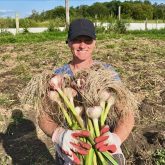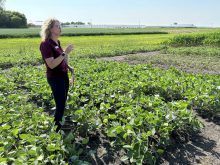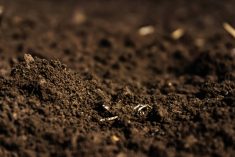An innovative water-trapping technique is making the desert bloom in one of the most inhospitable regions of sub-Saharan Africa.
Demi-lunes — holes in the shape of a semi-circle — are used to capture and store run-off rainwater.
It’s a simple low-tech water-harvesting method which enables crops to grow in a hostile climate.
The water conservation technique is one of several used in West Africa to support local agriculture and encourage self-sufficiency.
A Canadian Food Grains Bank accounting team from Winnipeg learned about demi-lunes during a recent trip to Niger to financially review CFGB-supported projects in the area.
Read Also

Thunderstorms and straight-line winds
Straight-line winds in thunderstorms can cause as much damage as a tornado and are next on our weather school list exploring how and why severe summer weather forms.
Niger, a former French colony, is located in the Sahel, a transitional zone between the Sahara desert in the north and the savanna region to the south. It has a hot, dry climate with average daytime temperatures ranging from 30 C in January to 40 C in May.
But it does rain, with annual average precipitation between 200 mm in the northern part of the country and 500 mm in the south.
The challenge is to capture that water and hold it where plants can use it directly.
That’s where demi-lunes come in.
Demi-lunes (French for “half-moons”) are small earth embankments built by hand. Contours are marked out on the bare ground and an A-frame is swung around to trace a semi-circle. The crust of the earth is broken with pickaxes and the soil dug out by spade. Small earthen bunds (dikes) are built up along the curve of the semi-circle. The demi-lunes are lined with manure and compost, and seeds are placed in and around them.
Slopes
Demi-lunes are best built on slopes with a gradient of less than two per cent to distribute water evenly.
When it rains, the bunds help retain run-off water in the demi-lunes. The stored water also percolates over the area, acting as subsurface irrigation.
Photographs show crops and green grass growing in and between rows of demi-lunes previously dug into degraded, crusted soil.
“They’re good agronomic practices,” said Alden Braul, a CFGB agriculture and livelihood program adviser. “Anything you can do to concentrate water and nutrients in an area to increase water-use efficiency, you are going to get better crops. And that’s what’s needed in those areas.”
Demi-lunes are used to grow subsistence crops, such as sorghum and millet, as well as forage for livestock. They can also help to establish local tree species.
Introduced in West Africa in the 1980s, demi-lunes are a simple, affordable way to rehabilitate land and help local farmers grow crops and raise livestock in areas previously plagued by droughts and erratic rainfall.
They are also readily built and easily maintained because all they require are hand tools. Some NGOs in Niger conduct demi-lune construction projects in which workers are paid for their labour in food.
Demi-lunes are similar to zai planting pits, another water-harvesting technique used in West Africa and other regions of the continent. Although smaller in size than demi-lunes, zai pits employ the same method to grow subsistence crops and establish trees and shrubs.
It’s a long way from the semi-arid regions of the Sahel to the Canadian Prairies. But the lessons learned from demi-lunes and zai holes have practical applications here, too, said Braul.
“The lesson is simply using locally appropriate tools and being as innovative as possible to conserve soil moisture and make the best possible use of nutrients.”
On-farm storage
Gary Martens, a University of Manitoba agriculture instructor, called demi-lunes and zai holes examples of on-farm water storage, which farmers around the world practise, sometimes following the simplest methods.
Martens recently spoke to a University of Manitoba agriculture diploma student whose family hopes to use Manitoba-style demi-lunes on their farm west of Portage la Prairie. The plan is to construct on-farm water storage ponds — not by digging holes, but by using earth scrapers to put up small berms in low spots on fields to trap run-off for irrigation later on.
Martens said some dryland potato farmers in the Winkler area are reportedly doing something similar by constructing small water storages on their fields to collect run-off.
Now that recent research shows decades of draining wetlands has increased perennial flood risks in Manitoba, producers are being urged to retain water on their land to control downstream flooding and reserve water supplies for on-farm use.
Martens said he is encouraged that landowners are starting to talk more about holding water back and less about draining it away as fast as possible.
“It’s taken a long time for people to start talking about keeping water on the land,” he said. “It’s about time.”
Low-tech approaches to water management can pay farmers dividends, whether in Manitoba or Niger, said Martens.
“It’s just that your eyes have to be open to the possibilities.”


















